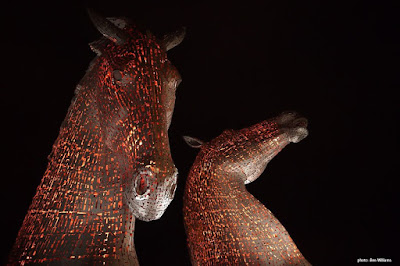The Kelpies @ The Helix, Grangemouth/Falkirk 17th May 2014
Andy Scott is the artist who designed and organised the build of the stunning equine heads by the side of the Forth and Clyde canal providing a glorious view from the passing M90 motorway. Although I had seen them thus (from the car), this was my first up close and personal visit to the monumental sculptures - with even an opportunity to walk inside the broad necks and view the Kelpies from within. |
| Photo courtesy of © andy scott public art ltd. 2014 |
 |
| Photo courtesy of © andy scott public art ltd. 2014 |
There are also many other examples of his work all over the UK here - The Works
However "The Kelpies" is/are his most recent, and largest work. They are the largest equine sculpture in the world, standing 30 metres (100 feet) tall. (There is another horsey statue in Mongolia which is taller, but only because there is a Genghis Khan on the horse's back - so this is the largest purely equine statue in the world.)
The Myth: Kelpie, or water-kelpie, is the Lowland Scottish name given to a water-spirit or demon inhabiting the lochs and waterways of Scotland. It has most often been described as appearing as a horse, but is supposedly able to adopt other forms, including those of beautiful women and handsome men.
From Andy Scott's web page - "Falkirk was my father’s home town and that inherited link to the town has been one of my driving inspirations. The mythological associations behind the original brief have been absorbed by other sources of inspiration in the creative processes, and the ancient ethereal water spirits have been forged into engineered monuments. The Kelpies are modelled on heavy horses and it is this theme of working horses which captured my imagination and drove the project. They are the embodiment of the industrial history of Scotland and the Falkirk / Grangemouth area. Heavy horses would once have been the powerhouse of the area, working in the foundries, the fields, farms and of course the canal itself, pulling boats along the Forth & Clyde from coast to coast."
Originally, the Kelpies had been intended to be functional as well as aesthetic, operating a "displacement lock system" to provide boat access to the canal from the River Carron and ultimately the Forth and the North Sea. One of the massive horse heads was to have rocked forward 5m (16ft) and the other was to have raised backwards by the same distance. The water displaced by this movement was supposed to fill a central lock to lift the boats into the Forth and Clyde canal. But, as the project dragged on, safety concerns were raised and in June 2011 the boat lift plan was scrapped due to "very complex and fluctuating engineering challenges". Despite its initial function being dropped, the plan for the sculptures went ahead and the canal still passes directly between the Kelpie heads.
The equine structures were based on two local heavy horses - Duke and Baron, and the guide often used these names when describing the structures - however they are officially "Head Up" and "Head Down" in the official signs and literature.
Quite beautiful either when viewed close-up, or at a distance framed against the Ochil Hills, anyone who tell you that this is not "art" (e.g. Jon Jones - Guardian art "critic") is talking out of their hindquarters.


No comments:
Post a Comment